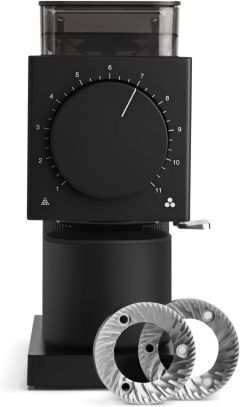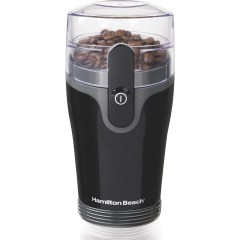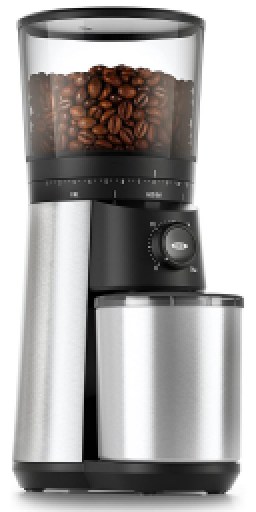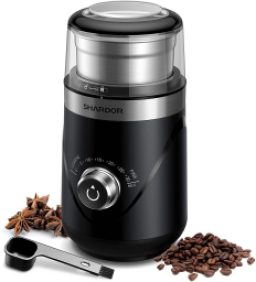Buying guide for Best coffee grinders
With a good coffee grinder, you can save a lot of money and time, and you may even learn to brew your own perfect cup of joe. The good news is that finding a coffee grinder to fulfill your needs is easier than ever.
There’s a pretty wide range of coffee grinders out there. Before you pick one, you’ll want to consider its capacity, power, speed, and ease of use. Some coffee grinders can grind 9 ounces of beans at a time, while others have up to 18 different speed settings. Many grinders on the market are electric, though manual grinders can be a more cost-effective choice.
The vital ingredients of excellent coffee
You only really need two things to make excellent coffee: clean water and freshly ground beans. Put those together in an old tin can over an open fire and the result will be pretty good.
However, most of us like a bit of refinement these days, so we separate grounds from liquid with a machine. Sometimes that means using a simple French press, and other times that means a high-tech espresso maker. Along the way, we hope to extract more flavor.
However, arguably the most important element of all when it comes to brewing the perfect cup of joe is the coffee grinder.
Freshly ground coffee makes the best cup, so we compare coffee grinders of different designs and builds to find the models that deliver the best overall results.
We cover both blade and burr grinders to determine which variety is best for different brewing methods.
Some burr grinders come with a built-in hopper that holds a moderate amount of whole beans before they are ground. We look at models with hoppers of various sizes, keeping capacity in mind.
Blade grinders are suitable for producing coarse grounds as well as whole spices. We compare these models to find the most versatile.
Different brewing methods require unique grind sizes. We look at coffee grinders with adjustable grind settings to find the most consistent and adaptable machines.
Coffee connoisseurs tend to love burr grinders with plenty of coarseness settings, so we look for models that let users fine-tune their grind to perfection.
We appreciate grinders with removable burrs for easy deep cleaning. This feature can give your machine a longer lifespan.
We look for burr grinders with built-in timers. This feature allows you to grind your coffee without supervision or button-mashing.
Our team compares blade grinders to find the models that produce consistent results while being easy to use.
Your coffee grinder should fit your brew needs as well as your space, so we take note of quality grinders that are also space-savers.
Why is having your own coffee grinder so important?
Even unground coffee beans go stale eventually. Air dries out the oils and leaches away the chemicals that give coffee its flavor in a process called oxidation.
The same thing happens with ground coffee, but because the air gets to each tiny particle, the effect is quicker and much more drastic.
Store-bought ground coffee is vacuum-packed in an attempt to slow oxidation. Some of these attempts are more successful than others. When consumers complain about the bitter taste in their coffee, air getting in is usually to blame.
Even if you go to that place on the corner and have a package ground while you wait, by the time you get home, oxidation will have started.
So, for the very finest coffee, the answer is to buy a good coffee grinder. Then you can grind only the amount you need, right before you make it.
Choosing the best coffee grinder
Modern coffee grinders offer a host of options, and we'll look at those in a moment. First, though, we need to resolve two basic dilemmas: manual or electric coffee grinder, and blade or burr?
Manual vs. electric
Our recommendation is simple: go with an electric grinder. Coffee has been ground by hand for hundreds of years, and some people still like the involvement of measuring beans into the grinder, putting the lid on, and turning the handle. We can understand the attraction to that process, and it obviously works, but there are flaws:
-
It's slow. Maybe that's OK if you're only making coffee for yourself, but what if you've got a dozen dinner guests?
-
The grind is inconsistent. Reproducing your preferred grind every time is almost impossible. It's also difficult to get fine grinds.
-
Some hand-powered coffee grinders are attractive because they're cheap, but cheap coffee grinders are often poorly made.
-
The good manual grinders, those that overcome these challenges, cost more than many electric coffee grinders.
Did you know?
Manual coffee grinders are slow and produce inconsistent results. High-quality manual grinders can cost more than electric grinders.
STAFF
BestReviews
Blade grinders
Blade coffee grinders are much like spice grinders. In fact, many popular models are sold to do both jobs. In a blade grinder, a powerful motor drives a stainless steel blade. The spinning blade isn't very sharp, but it is very fast and pulverizes the coffee bean into smaller and smaller pieces. The longer you keep it going, the finer the grind.
Blade grinders offer a few advantages:
-
It’s a simple mechanism, so there’s little to go wrong.
-
Blade grinders are small and easy to store when not in use.
-
These grinders are typically multifunctional. Seeds and spices can be ground, as well as coffee. However, careful cleaning is needed to avoid flavor contamination.
-
Blade grinders are typically low in cost.
There are also some disadvantages to blade grinders:
-
Blade grinders are very noisy.
-
They don’t have pre-sets, so grind consistency is difficult.
-
Ground coffee stays in the same bowl as beans that may not get thoroughly processed.
-
Rapid speed can overheat beans/grounds and spoil the flavor.
-
These grinders have small bowl sizes. If you're having a dinner party, you may need to make two or more batches.
"Blade grinders usually have smaller bowls than burr grinders, so they aren’t the best choice for serving large numbers of people."
STAFF
BestReviews
There are ways to overcome some of the disadvantages.
You can time your grinding for improved consistency. You can shake the grinder so you get a more even grind – make sure the lid is secure. You can stop from time to time so the contents don't get too hot.
All of these things might feel like a bit of a nuisance. However, blade grinders are a cheap, reliable, and convenient option for the occasional coffee drinker.
Burr grinders
Burr coffee grinders use contoured disks or cones to crush the beans. Usually, they are steel, but occasionally they’re ceramic. The gap between the disks is adjustable, providing different consistencies of grind.
Some burr grinder advantages include:
-
Much greater control. Fine to coarse, it's easy to choose the grind you want, and easy to change to a different one.
-
The grind is consistent, time after time.
-
Burrs grind more slowly, so there's no flavor loss through overheating.
-
Grounds end up in a separate hopper.
-
These machines usually have greater capacity than blade grinders.
-
Burr grinders are quieter.
-
Some burr grinders can be left to work unattended.
"Burr grinders employ opposing steel or ceramic disks, crushing the beans in between. The disks are adjustable, which allows for different consistency grinds."
STAFF
BestReviews
Burr grinders do have a few disadvantages:
In essence, burr coffee grinders are much kinder to your coffee beans, retaining more flavor. Coffee connoisseurs invariably choose burr grinders. They are also what you find in coffee shops, bars, and restaurants.
Did you know?
A burr grinder separates the grounds into a separate hopper, so the grounds won’t be mixed with any partially processed beans.
STAFF
BestReviews
Additional coffee grinder features
-
Blade grinders usually have a simple push-button operation. Often this combines with a lid lock.
-
Some blade grinders have a convenient, retractable cord.
-
Many models have dishwasher-safe components – but not all of them do, so always check.
-
The grinder might also come with a cleaning brush.
-
Some burr grinders have removable burrs, so thorough cleaning is easier.
-
A few models have timers, allowing you to leave them to finish on their own.
Coffee grinder prices
We've heard some experts say that if you spend $250 on a coffee machine, you should spend the same on the grinder. We don't think you need to go that high, but there's no doubt that investing in a burr grinder will give you a better result, every time.
Inexpensive
If you're after speed and efficiency on a budget, a blade grinder will do the trick and will cost $20 to $25.
Mid-range
Good burr coffee grinders start around $45. That's not a lot for significantly better ground coffee than you'd get from a blade version.
High-end
You can easily spend $90 to $150 for models with ceramic burrs, timers, and other features. You'll get extras that make your life easier, but you won't necessarily get a better grind.
"Burr grinders process beans more slowly, so there’s less risk of increasing bitterness through burning."
STAFF
BestReviews
What about the water?
The freshest ground coffee in the world will be wasted if you've got bad water, but just how fussy should you be?
Some coffee lovers take an enormous amount of care with their liquid additive, checking mineral content, TDS (total dissolved solids), and even mixing water from different sources to get precise results.
Most people won't go that far, but water that's too hard or too soft will work against you.
-
Water that's too soft won't release the full flavor from your ground coffee.
-
The minerals in water that is too hard will affect flavor, too.
-
Hard water also causes scale deposits that can shorten the life of your machine.
Avoid distilled water because it has too little mineral content. Jug-type water filters are fine, but again, they can remove some things you'd rather keep.
The best solution is also possibly the easiest. The ordinary drinking water you buy at the supermarket – not the designer brand, just the everyday one – is as close to perfect as most of us need.
Some might argue their tap water is just as good. If yours is, go ahead and use it!






























































